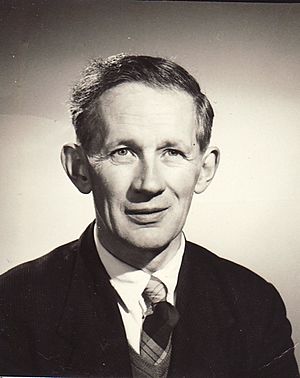Neil Leslie Webster facts for kids
Neil Leslie Webster (born November 7, 1906 – died 1990) was a British Army officer who worked in intelligence during World War II. He was a very important person in radio intelligence and cryptography (code-breaking). He worked in a special place called the Fusion Room at Bletchley Park. He was deeply involved in finding "cribs" to help break codes from the Enigma machine. Before the war, he worked as a literary agent, helping authors with their books. After the war, he worked for the government at the Central Office of Information.
Early life and education
Neil Webster was born on November 7, 1906, in Wales. His family was Scottish. His grandmother was Flora Annie Steel, a well-known writer from the Victorian era. She wrote about India and was famous for her strong opinions and work for women's rights there. She had a big influence on Neil, teaching him to think for himself.
Neil's parents worked in India, so his grandparents raised him. In 1920, he won a scholarship to Cheltenham College. There, he studied languages like Latin, Greek, French, and German. He was also very good at mathematics. He had a natural talent for numbers, logic, and solving complex problems.
He went to Oxford University and then Cambridge University. He studied different subjects, including Industrial Psychology. Later, he traveled in North America. He became involved in the writing world in New York before returning to England. Back home, he worked as a literary agent.
Wartime work and code-breaking
In 1939, Neil married Elizabeth Heygate. In the same year, he joined the London Scottish Reserve, a military group. In 1940, he was recruited to MI8, a British intelligence agency. He worked on radio intelligence and code-breaking until 1946. This job needed a very logical mind, strong math skills, and the ability to think in new and creative ways. Neil had all these qualities.
When he joined MI8 in April 1940, he was part of the first group in Caxton Street, London. Here, they came up with the idea of "fusion." This meant combining information from radio signals with decrypted (decoded) messages. This helped them get a full picture of what the enemy was doing.
The unit he worked in became known as the "Fusion Room." It moved to different locations, finally ending up at Bletchley Park (BP). At Bletchley Park, Neil Webster was a Major. He was the link between the people who analyzed radio signals and the code-breakers. This unit is now known as SIXTA.
The Fusion Room at Bletchley Park was the main place where German messages were decoded. They compared these messages with information from daily radio traffic. This helped them understand the enemy's plans and movements during the war.
Neil's job was to help find "cribs." Cribs were short parts of coded messages where the meaning was already known or could be guessed. Finding these cribs was very important because they helped to break the entire code. He especially helped the teams working to break the Enigma machine code. This allowed important information to reach the intelligence teams. After the war, Neil and his colleagues wrote the official history of SIXTA.
After the war
In 1947, Neil Webster started working for the Central Office of Information. He was in charge of publishing "The Britain Handbook" each year. He retired in 1976 when he was 70 years old.
During his retirement, he began writing a book called Cribs for Victory. This book was about his important wartime work in intelligence. It described in detail how they searched for cribs for the Enigma machine. These cribs were crucial for decoding messages. They were also used to create "menus" for the "bombes," which were early computers developed at Bletchley Park.
Unfortunately, the permission he first received to publish his book was taken away in 1985. This was due to security reasons. Neil Webster passed away in Gloucestershire in 1990. He left behind his wife, three children, and many grandchildren. After his death and his wife's death in 2007, his daughter, Joss Pearson, worked to get new permission to publish her father's book. It was finally published in 2011 with extra material.
Neil Webster was a very intelligent man. He was a brilliant mathematician, a scholar of classical languages, and good at many languages. He loved reading and art. He was known for being liberal, polite, charming, and very kind. His family and friends remembered him as a wise and engaging person, always ready for a good discussion or challenge.


